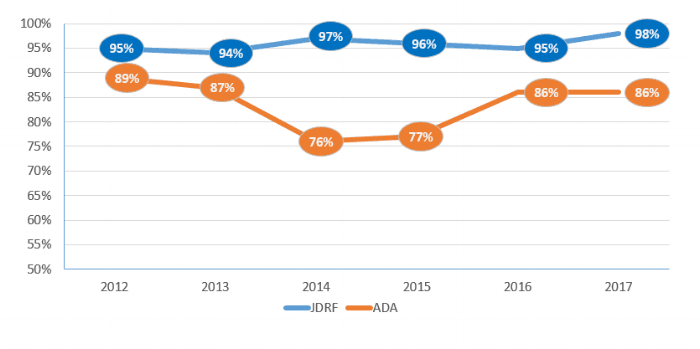
This is the sixth annual review of advertising messages used by the ADA and JDRF at national fundraising events. In 2017, the ADA and JDRF will host a total of 324 events including walks, rides, and galas. Combined, these events generate over $350 million in donations. These events are a prime source of funding for both organizations and compromise nearly 3/4 of JDRF annual income and 1/3 of ADA annual income. In conducting this analysis, the JDCA individually reviewed each of the 324 events.
Our analysis finds almost all JDRF and ADA fundraising events promise to use proceeds to find a cure, but only a small portion of the money raised is actually used for cure research. The majority of the funds are used for other activities including non-cure research, overhead, fundraising, and publications, as shown in the opening chart.
Key Takeaways
- Supporting cure research is the principal fundraising promise: 98% of JDRF’s national fundraising events and 86% of the ADA’s events in 2017 feature a promise to fund cure research.
- Overuse of the cure promise is now a six-year trend: See Appendix A below.
- The fundraising promise is inconsistent with actual use: Only 7% of JDRF’s annual revenue and less than 3% of the ADA’s annual revenue was used for cure research.
- JDRF increases its reliance on the cure promise: The percentage of JDRF events which featured a cure promise increased from 95% in 2016 to 98% in 2017.
- The percentage of ADA events which rely on a cure promise remains at 86%
- Donors want their money spent on cure research: JDCA quantitative tracking surveys found the majority of participants and donors at fundraising events rank cure research as their top funding priority.
- 92% of T1D donors state that the main reason they choose to give money to a diabetes charity and/or participate in a fundraising walk is to support cure research.
- 96% state they believe cure research should be the number one priority for major diabetes charitable organizations.
JDCA Commentary
Both the ADA and JDRF continue to mine promise of a cure as their primary fundraising message. Yet, as written about previously by the JDCA, the amount of money that actually reaches cure research has been declining for over a decade at JDRF and has remained at minimal levels at the ADA. The JDCA believes the ADA and JDRF research funding levels should match the high percentage of cure promise advertising. Each organization has a moral imperative to either increase cure research spending or decrease the percentage of advertisements which rely on the cure promise and exploits their donors passion for finding a T1D cure.
Appendix A: Percentage of Franchise Events that Promise Proceeds will be Used for Cure Research

